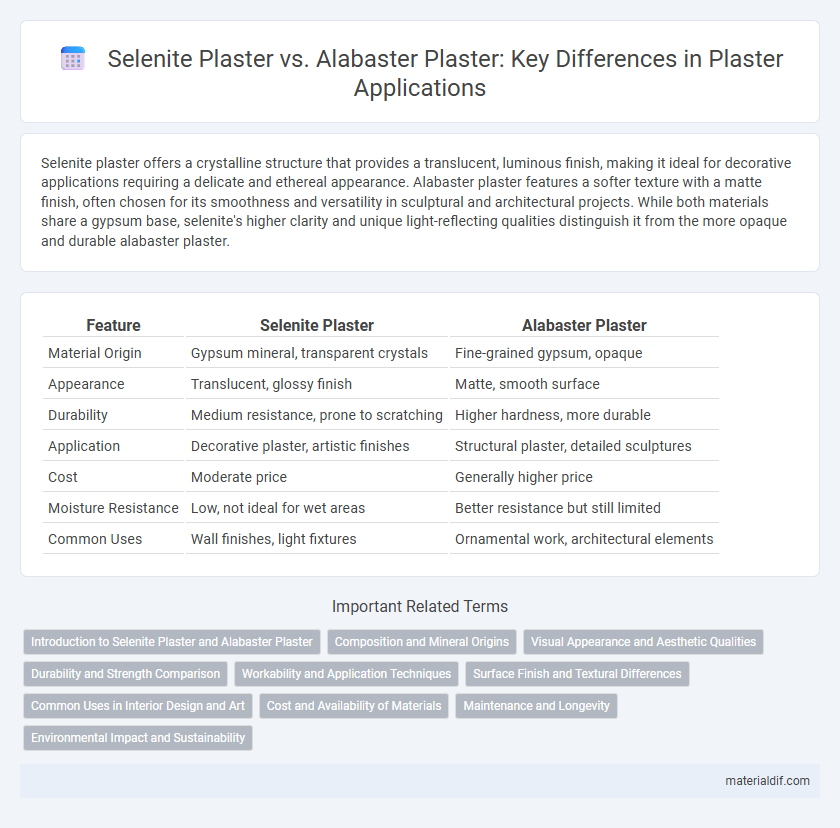Selenite plaster offers a crystalline structure that provides a translucent, luminous finish, making it ideal for decorative applications requiring a delicate and ethereal appearance. Alabaster plaster features a softer texture with a matte finish, often chosen for its smoothness and versatility in sculptural and architectural projects. While both materials share a gypsum base, selenite's higher clarity and unique light-reflecting qualities distinguish it from the more opaque and durable alabaster plaster.
Table of Comparison
| Feature | Selenite Plaster | Alabaster Plaster |
|---|---|---|
| Material Origin | Gypsum mineral, transparent crystals | Fine-grained gypsum, opaque |
| Appearance | Translucent, glossy finish | Matte, smooth surface |
| Durability | Medium resistance, prone to scratching | Higher hardness, more durable |
| Application | Decorative plaster, artistic finishes | Structural plaster, detailed sculptures |
| Cost | Moderate price | Generally higher price |
| Moisture Resistance | Low, not ideal for wet areas | Better resistance but still limited |
| Common Uses | Wall finishes, light fixtures | Ornamental work, architectural elements |
Introduction to Selenite Plaster and Alabaster Plaster
Selenite plaster is a highly translucent material derived from the gypsum mineral selenite, known for its delicate, crystalline structure and smooth finish, often used in decorative and architectural applications. Alabaster plaster, made from fine-grained gypsum or calcite, features a creamy, opaque appearance and is prized for its workability and soft texture in sculpting and ornamental detailing. Both plasters share a gypsum base but differ in translucency and grain, influencing their selection for aesthetic and functional purposes.
Composition and Mineral Origins
Selenite plaster is primarily composed of the mineral gypsum, a hydrous calcium sulfate known for its transparent to translucent crystal structure originating from sedimentary deposits. Alabaster plaster, while also derived from gypsum, contains finer-grained, more compact calcium sulfate which is often conflated with varieties of calcite-based alabaster found in metamorphic contexts. Both plasters differ in mineral purity and crystal morphology, influencing their translucency and workability in artistic and architectural applications.
Visual Appearance and Aesthetic Qualities
Selenite plaster exhibits a translucent, crystalline appearance with a slight shimmer that enhances its luminous and ethereal aesthetic qualities. Alabaster plaster, on the other hand, is characterized by a smooth, opaque surface with subtle veins and a creamy, matte finish that provides a classic and elegant look. The choice between selenite and alabaster plaster heavily influences the visual impact of interiors, with selenite offering a modern, radiant glow and alabaster delivering timeless warmth and depth.
Durability and Strength Comparison
Selenite plaster exhibits higher durability and greater tensile strength compared to alabaster plaster, making it more suitable for structural applications and long-lasting installations. While alabaster plaster is prized for its fine texture and translucency, it is more prone to chipping and weathering under stress or impact. The crystalline structure of selenite enhances its resistance to cracks and wear, ensuring better performance in demanding environments.
Workability and Application Techniques
Selenite plaster exhibits superior workability due to its finer crystal structure, allowing smoother application and detailed finishing compared to alabaster plaster, which tends to be coarser and more brittle. The application techniques for selenite plaster often involve thin, even layers that enhance its translucency and aesthetic appeal, while alabaster plaster requires thicker coats and more careful handling to prevent cracking. Understanding these differences helps artisans choose the right plaster type for intricate interior designs and restoration projects.
Surface Finish and Textural Differences
Selenite plaster offers a smooth, translucent surface finish with a slight crystalline shimmer, making it ideal for decorative applications that require subtle light diffusion. Alabaster plaster has a more opaque, matte finish with a finer, softer texture, providing a warm and natural appearance suited for sculptural and architectural details. The difference in surface finish stems from selenite's crystalline structure, which enhances luminosity, whereas alabaster's finer grain results in a more uniform, muted aesthetic.
Common Uses in Interior Design and Art
Selenite plaster is prized in interior design for its translucent quality and smooth finish, making it ideal for creating luminous wall surfaces and decorative features that enhance ambient lighting. Alabaster plaster, known for its fine grain and soft texture, is commonly used in artistic applications such as sculpting intricate details and crafting ornamental moldings. Both materials are valued for their ability to be easily carved and polished, contributing to elegant and refined interior aesthetics.
Cost and Availability of Materials
Selenite plaster is generally more expensive than alabaster plaster due to the rarity and larger crystal size of selenite, which increases production costs. Alabaster plaster benefits from wider availability and lower extraction costs, making it a more economical choice for large-scale projects. Both materials are accessible, but alabaster's abundance in commercial deposits ensures consistently lower prices and easier sourcing.
Maintenance and Longevity
Selenite plaster offers superior durability and requires minimal maintenance due to its dense crystal structure, resisting moisture and cracking better than alabaster plaster. Alabaster plaster, while aesthetically pleasing with its translucent quality, tends to be softer and more porous, necessitating regular sealing and careful cleaning to prevent damage. Long-term, selenite plaster outperforms alabaster in longevity, making it a preferred choice for high-traffic or humid environments.
Environmental Impact and Sustainability
Selenite plaster, derived from natural gypsum crystals, offers a lower environmental impact due to its abundant availability and energy-efficient processing compared to alabaster plaster, which is typically sourced from less sustainable alabaster stone quarries. The production of selenite plaster results in reduced carbon emissions and minimal habitat disruption, making it a more sustainable choice for eco-conscious construction and interior design projects. In contrast, alabaster plaster's extraction often involves significant landscape alteration and higher energy consumption, contributing to a larger ecological footprint.
Selenite Plaster vs Alabaster Plaster Infographic

 materialdif.com
materialdif.com